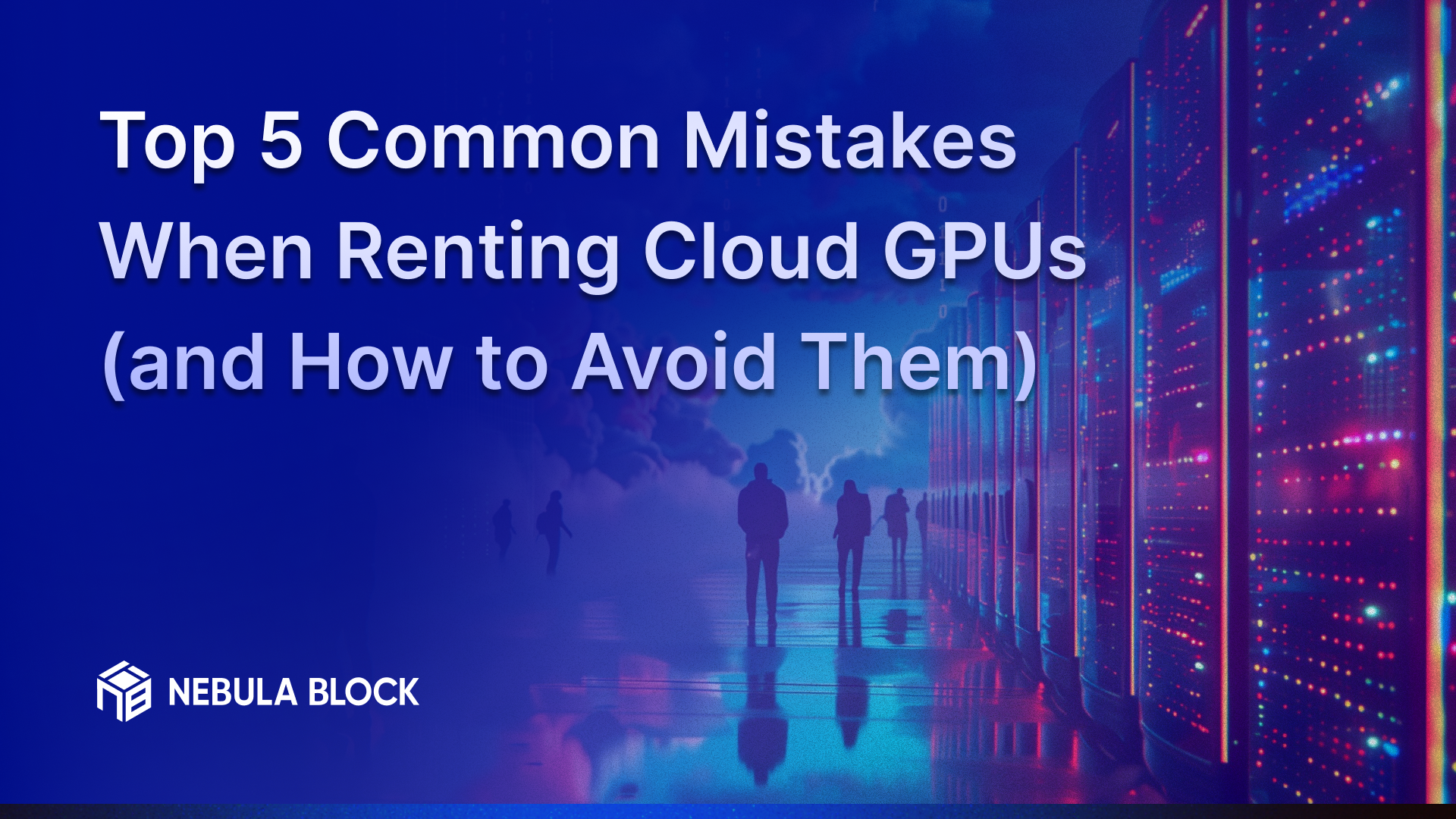Top 5 Common Mistakes When Renting Cloud GPUs (and How to Avoid Them)

Cloud GPUs have become the backbone of AI training, fine-tuning, and inference — giving teams on-demand access to powerful hardware without heavy upfront investment.
Yet, many users unknowingly waste money, run into compatibility headaches, or compromise security simply because they overlook a few fundamentals.
Below are the five most common mistakes people make when renting cloud GPUs — and how you can avoid them to get maximum performance, cost efficiency, and reliability.
1. Misaligned GPU Selection and Sizing
Mistake:
Many users either pick a GPU that’s not suited to their workload or pay for far more power than they actually need. Both waste budget and slow down project timelines.
How to Avoid:
- Match GPU architecture to your workload:
- Large-scale AI training → NVIDIA A100, H100, or H200 for high memory and throughput.
- Lightweight inference, small model fine-tuning, or rendering → RTX 4090, 5090, or L40S for better cost efficiency.
- Right-size your resources: More VRAM and cores don’t always mean faster results. Test on smaller instances before committing.
- Use provider recommendations: Most cloud platforms offer workload-based suggestions — leverage them to make data-driven decisions.
💡 On Nebula Block, you can pick from consumer-grade RTX to data-center grade H100/H200, and even bare metal for maximum throughput.
2. Not Monitoring Usage or Costs
Mistake:
Running workloads and forgetting about them — leaving instances active overnight or during weekends, especially after failed training runs.
How to Avoid:
- Set up usage alerts and daily cost summaries.
- Always terminate idle VMs or pause them between tasks.
- Use job schedulers or auto-shutdown scripts to prevent waste.
💡 Nebula Block provides cost tracking dashboards and easy one-click shutdown, so you can catch idle time before it burns your budget.
3. Ignoring Idle Time
Mistake:
Keeping expensive GPU instances online while models are downloading datasets, preprocessing, or waiting in queues.
Your GPU isn’t doing work during these phases — but you’re still paying for it.
How to Avoid:
- Preprocess data on cheaper CPU instances before spinning up GPU nodes.
- Download large datasets or models to persistent object storage ahead of time.
- Only launch GPU nodes when training or inference is ready to run.
💡 With Nebula Block’s S3-compatible Object Storage, you can store datasets and models persistently, then mount them instantly to GPU instances when needed.
4. Not Checking Compatibility (Frameworks, Drivers, OS)
Mistake:
Launching a GPU VM and then realizing your training code won’t run because of CUDA mismatch, missing drivers, or unsupported framework versions.
How to Avoid:
- Confirm CUDA, PyTorch, TensorFlow, and OS versions before provisioning.
- Use containerized environments (Docker) to ensure portability.
- Pick cloud providers that pre-install common AI stacks to save setup time.
💡 Nebula Block offers preconfigured images for popular AI frameworks — ready to train in minutes without driver headaches.
5. Poor Security Practices
Mistake:
Leaving SSH ports open to the world, using weak passwords, or storing API keys unencrypted.
Security isn’t just about data leaks — it’s about preventing hijacked compute that can rack up costs or mine crypto on your bill.
How to Avoid:
- Always use SSH key authentication, not passwords.
- Restrict access to trusted IPs.
- Never hardcode keys in code — use environment variables or secret managers.
💡 Nebula Block supports key-based authentication, firewall rules, and isolated private networks for safer GPU usage.
Why Nebula Block
Nebula Block is Canada's first sovereign AI cloud, built to give developers, researchers, and enterprises maximum flexibility and control over their GPU workflows:
- Wide GPU range: From cost-effective RTX 4090/5090 to enterprise-class accelerators like NVIDIA B200, H200, H100 and more for large-scale training.
- Pay-as-you-go billing.
- Preconfigured AI environments for zero-setup training.
- Persistent object storage for datasets, checkpoints, and models.
- Secure networking with private networking and firewall controls.
With infrastructure across Canada and globally, Nebula Block ensures low-latency access for users worldwide. It also offers on-demand and reserved GPU instances, plus a wide range of pre-deployed inference endpoints—including DeepSeek V3 and R1 free of charge—so you can instantly experiment with state-of-the-art large language models.
Whether you’re fine-tuning a small model or running multi-node training, the right GPU choices and best cloud practices can mean the difference between burning budget and building breakthroughs.
Conclusion
Renting cloud GPUs offers immense potential for scaling machine learning workloads, but it comes with its challenges. By avoiding these common mistakes, you can optimize your cloud experience.
To further enhance your cloud GPU journey, consider leveraging the robust infrastructure provided by Nebula Block, which offers competitive rates and a supportive community to guide you through your machine learning projects.
What’s Next?
Sign up and explore now.
🔍 Learn more: Visit our blog and documents for more insights or schedule a demo to optimize your search solutions.
📬 Get in touch: Join our Discord community for help or Contact Us.
Stay Connected
💻 Website: nebulablock.com
📖 Docs: docs.nebulablock.com
🐦 Twitter: @nebulablockdata
🐙 GitHub: Nebula-Block-Data
🎮 Discord: Join our Discord
✍️ Blog: Read our Blog
📚 Medium: Follow on Medium
🔗 LinkedIn: Connect on LinkedIn
▶️ YouTube: Subscribe on YouTube